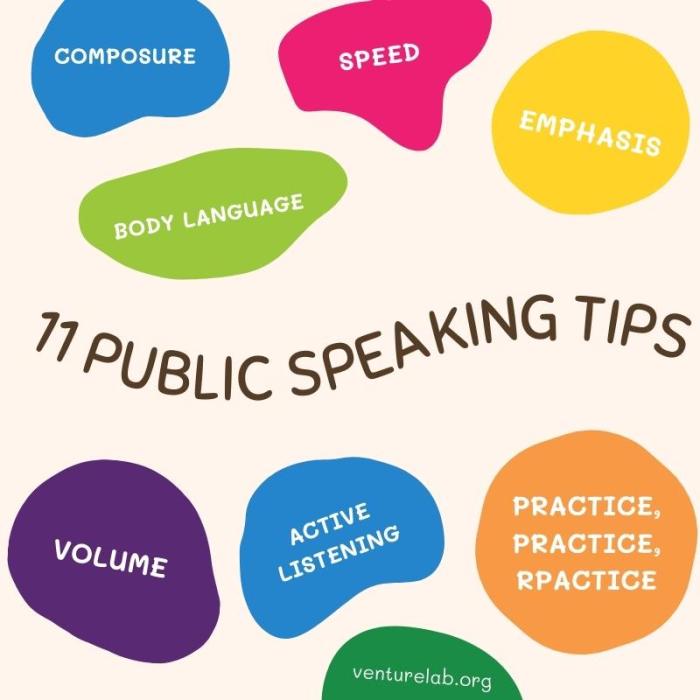Public Speaking Tips will take you on a journey to conquer your fears and captivate any crowd with confidence and style. Get ready to unlock the secrets of effective communication in any setting.
From mastering the stage to structuring a compelling speech, this guide has all you need to shine in the spotlight.
Importance of Public Speaking: Public Speaking Tips

Public speaking skills are crucial in various aspects of life as they enable individuals to effectively communicate their ideas, influence others, and showcase their expertise. Whether it’s presenting in front of a large audience, participating in a job interview, or leading a team meeting, strong public speaking abilities can make a significant impact on one’s success and opportunities.
Enhanced Communication
Improving public speaking abilities can boost confidence and credibility, leading to better relationships with colleagues, clients, and peers. Clear and articulate communication is key in conveying messages effectively and gaining the trust and respect of others. By honing public speaking skills, individuals can articulate their thoughts with clarity, persuade others to their point of view, and establish themselves as competent and knowledgeable professionals.
Career Advancement
In the professional world, public speaking skills are highly valued and can open doors to new opportunities. Whether it’s delivering a compelling presentation, pitching ideas to investors, or representing a company at conferences, individuals with strong public speaking abilities are more likely to stand out and advance in their careers. Effective communication is essential in building a personal brand, networking with industry professionals, and showcasing leadership potential.
Personal Growth
Beyond the professional realm, improving public speaking skills can also lead to personal growth and development. Overcoming the fear of public speaking, honing storytelling techniques, and mastering nonverbal communication can boost self-esteem, enhance social interactions, and empower individuals to express themselves confidently in various settings. Ultimately, strong public speaking skills can contribute to overall success and fulfillment in both personal and professional life.
Overcoming Stage Fright

When it comes to public speaking, stage fright is a common issue that many people face. The fear of speaking in front of an audience can be overwhelming, but there are ways to manage nervousness and build confidence on stage.
Understanding Stage Fright
- One common reason for stage fright is the fear of being judged or criticized by the audience.
- Another reason is the fear of making mistakes or forgetting what to say.
- To manage nervousness before speaking in public, it’s important to practice and prepare thoroughly.
Techniques for Calming Nerves
- Practice deep breathing exercises to help calm your nerves before going on stage.
- Visualize yourself giving a successful speech and receiving positive feedback from the audience.
- Avoid caffeine and eat a light meal before speaking to prevent jitteriness.
Importance of Practice and Preparation
- Rehearse your speech multiple times to build confidence and reduce the fear of forgetting what to say.
- Prepare cue cards or notes to help guide you through your speech in case you get nervous.
- Practice speaking in front of a mirror or record yourself to identify areas for improvement.
Structuring a Speech
When it comes to delivering a powerful speech, structuring your content is key to capturing your audience’s attention and effectively conveying your message. A well-structured speech typically consists of three main components: the introduction, body, and conclusion.
Key Components of a Well-Structured Speech
- Introduction: Start strong with a captivating opening that grabs the audience’s attention. Clearly state the purpose of your speech and provide a preview of what will be covered.
- Body: This is where you delve into the main points of your speech. Organize your content logically, using transitions to smoothly guide your audience from one point to the next. Support your ideas with relevant examples, data, or anecdotes to keep your audience engaged.
- Conclusion: Wrap up your speech by summarizing the key points discussed and reinforcing your main message. End with a memorable closing statement that leaves a lasting impact on your audience.
Tips for Effective Organization
- Audience Engagement: Tailor your content to resonate with your audience’s interests and needs. Use storytelling, humor, or interactive elements to keep your audience engaged throughout your speech.
- Clear Message: Define a clear and concise message that you want to convey. Structure your speech around this central message to ensure coherence and relevance.
- Visual Aids: Utilize visual aids such as slides, props, or videos to enhance the delivery of your speech and reinforce key points.
- Practice: Rehearse your speech multiple times to become familiar with the content and delivery. Practice pacing, tone, and body language to communicate your message effectively.
Importance of a Clear Message
In the midst of structuring your speech, it is crucial to ensure that your message is communicated clearly and effectively. A clear message helps your audience grasp the main idea of your speech and facilitates better understanding and retention of the content. To ensure effective communication of your message, use simple language, avoid jargon, and provide concrete examples to support your points.
Engaging the Audience
To truly captivate your audience from the start of your speech, it’s essential to employ various strategies that grab their attention and keep them engaged throughout. Utilizing storytelling, humor, and visual aids can significantly enhance the impact of your presentation and make it more memorable for your listeners.
Using Storytelling
Storytelling is a powerful tool that can help you connect with your audience on a personal level. By sharing relevant anecdotes or narratives that convey your message, you can make your speech more relatable and engaging. For example, instead of simply stating facts and figures, you could illustrate your points through a compelling story that resonates with your audience.
Incorporating Humor
Humor is another effective way to liven up your speech and keep your audience entertained. Adding a touch of humor through jokes, witty remarks, or humorous anecdotes can help break the ice and create a more relaxed atmosphere. Just be mindful of your audience’s sensibilities and ensure that your humor is appropriate for the occasion.
Using Visual Aids
Visual aids, such as slides, videos, or props, can complement your speech and provide a visual representation of your key points. Visual aids not only help reinforce your message but also cater to different learning styles among your audience members. For instance, you could use infographics to present data in a more visually appealing format or incorporate videos to illustrate complex concepts.
Interactive Techniques, Public Speaking Tips
Engaging your audience through interactive techniques can make your presentation more dynamic and memorable. Encourage audience participation by asking questions, conducting polls, or incorporating group activities. For example, you could pose thought-provoking questions for the audience to discuss in pairs or small groups, fostering a sense of involvement and collaboration.



